
Lakshmi, also known as Shri, is one of the principal goddesses in Hinduism. She is the goddess of wealth, fortune, power, beauty, fertility and prosperity, and associated with Maya ("Illusion"). Along with Parvati and Saraswati, she forms the Tridevi of Hindu goddesses.

Diwali is the Hindu festival of lights with its variations also celebrated in other Indian religions. It symbolises the spiritual "victory of light over darkness, good over evil, and knowledge over ignorance". Diwali is celebrated during the Hindu lunisolar months of Ashvin and Kartika—between around mid-September and mid-November. The celebrations generally last five or six days.
Ritu or Kalanilai means "season" in different ancient Indian calendars used in India, Bangladesh, Nepal and Sri Lanka. There are six ritus or seasons. Seasons are different times of the year and there are 12 months in the year. Every month has its own special season. The word is derived from the Vedic Sanskrit word Ṛtú, a fixed or appointed time, especially the proper time for sacrifice (yajna) or ritual in Vedic religion; this in turn comes from the word Ṛta (ऋत), as used in Vedic Sanskrit literally means the "order or course of things". This word is used in nearly all Indian languages.

Holi is a popular and significant Hindu festival celebrated as the Festival of Colours, Love, and Spring. It celebrates the eternal and divine love of the deities Radha and Krishna. Additionally, the day signifies the triumph of good over evil, as it commemorates the victory of Vishnu as Narasimha over Hiranyakashipu. Holi originated and is predominantly celebrated in the Indian subcontinent, but has also spread to other regions of Asia and parts of the Western world through the Indian diaspora.
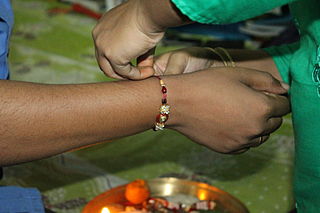
Raksha Bandhan is a popular and traditionally Hindu annual rite or ceremony that is central to a festival of the same name celebrated in South Asia. It is also celebrated in other parts of the world significantly influenced by Hindu culture. On this day, sisters of all ages tie a talisman or amulet called the rakhi around the wrists of their brothers. They symbolically protect them, receive a gift in return, and traditionally invest the brothers with a share of the responsibility of their potential care.
Guru Purnima (Poornima) is a religious festival dedicated to offering respect to all the spiritual and academic gurus. It is celebrated as a festival in India, Nepal and Bhutan by Hindus, Jains and Buddhists. This festival is traditionally observed to honour one's chosen spiritual teachers or leaders. It is observed on the full moon day (Purnima) in the month of Ashadha (June–July) according to the Hindu Calendar. The festival was revived by Mahatma Gandhi to pay tribute to his spiritual guru, Shrimad Rajchandra. It is also known as Vyasa Purnima, for it marks the birthday of Veda Vyasa, the sage who authored the Mahabharata and compiled the Vedas.

Śrāvaṇa is the fifth month of the Hindu calendar. In India's national civil calendar, Śrāvaṇa is the fifth month of the year, beginning on July 23 and ending on August 22. In the Tamil calendar, it is known as Āvani and is the fifth month of the solar year. In lunar religious calendars, Śrāvaṇa begins on the new moon or the full moon and is the fifth month of the year. Srabon is the fourth month of the solar Bengali calendar. It is also the fourth month of the Nepali calendar. Śrāvaṇa is also the second month of Varsha.

Dakṣiṇāmnāya Śrī Śāradā Pīṭham or Śri Śṛṅgagiri Maṭha is one amongst the four cardinal pīthams following the Daśanāmi Sampradaya - the peetham or matha is said to have been established by acharya Śrī Ādi Śaṅkara to preserve and propagate Sanātana Dharma and Advaita Vedānta, the doctrine of non-dualism. Located in Śringerī in Chikmagalur district in Karnataka, India, it is the Southern Āmnāya Pītham amongst the four Chaturāmnāya Pīthams, with the others being the Dvārakā Śāradā Pītham (Gujarat) in the West, Purī Govardhana Pīṭhaṃ (Odisha) in the East, Badri Jyotishpīṭhaṃ (Uttarakhand) in the North. The head of the matha is called Shankarayacharya, the title derives from Adi Shankara.

Hanuman Jayanti is a Hindu festival celebrating the birth of the Hindu deity, and one of the protagonists of the Ramayana, Hanuman. The celebration of Hanuman Jayanti varies by time and tradition in each state of India. In most northern states of India, the festival is observed on the full-moon day of the Hindu month of Chaitra. In Karnataka, Hanuman Jayanti is observed on Shukla Paksha Trayodashi, during the Margashirsha month or in Vaishakha, while in a few states like Kerala and Tamil Nadu, it is celebrated during the month of Dhanu. Hanuman Jayanti is observed on Pana Sankranti in the eastern state of Odisha, which coincides with the Odia New Year.
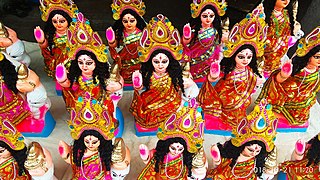
Sharad Purnima is a religious festival celebrated on the full moon day of the Hindu lunar month of Ashvin, marking the end of the monsoon season. The full moon night is celebrated in different ways in various cultural regions across Indian subcontinent.
Paksha (Sanskrit: पक्ष, romanized: pakṣa) refers to a fortnight or a lunar phase in a month of the Hindu lunar calendar.
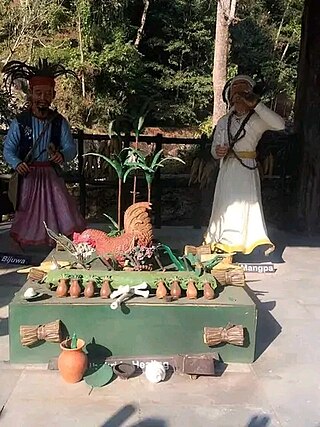
Kirat Mundum, also known as Kiratism, or Kirati Mundum, is an animistic folk religion of the Kirati ethnic groups of Nepal, Darjeeling and Sikkim, majorly practiced by Yakkha, Limbu, Sunuwar, Rai, Thami, Jirel, Hayu and Surel peoples in the north-eastern Indian subcontinent. The practice is also known as Kirat Veda, Kirat-Ko Veda or Kirat Ko Ved. According to some scholars, such as Tom Woodhatch, it is a blend of shamanism, animism, and Shaivism. It is practiced by about 3.17% of the Nepali population as of 2021.
Chaturdashi is the 14th day (tithi) of the waxing phase or waning phase of the moon in the Hindu calendar. This is the day prior to new moon (amavasya) or full moon (purnima).

Chaturmasya, also rendered Chāturmāsa, is a holy period of four months, beginning on Shayani Ekadashi (June-July) and ending on Prabodhini Ekadashi (October-November) in Hinduism. This period also coincides with the monsoon season in India.
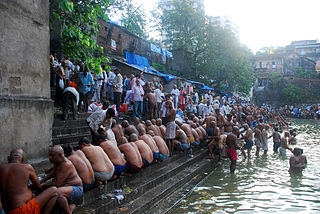
Pitru Paksha, also spelt Pitri Paksha, is a 16-lunar day period in the Hindu calendar when Hindus pay homage to their ancestors (Pitrs), especially through food offerings. The period is also known as Pitri Paksha/Pitr-Paksha, Pitri Pokkho, Sorah Shraddha, Kanagat, Jitiya, Mahalaya, Apara Paksha and akhadpak.

Navaratri is an annual Hindu festival observed in honour of the goddess Durga, an aspect of Adi Parashakti, the supreme goddess. It spans over nine nights, first in the month of Chaitra, and again in the month of Ashvin (September–October). It is observed for different reasons and celebrated differently in various parts of the Hindu Indian cultural sphere. Theoretically, there are four seasonal Navaratri. However, in practice, it is the post-monsoon autumn festival called Sharada Navaratri.

Prabodhini Ekadashi, also known as Deva Uttana Ekadashi, is the 11th lunar day (ekadashi) in the bright fortnight of the Hindu month of Kartika. It marks the end of the four-month period of Chaturmasya, when the god Vishnu is believed to be asleep. It is believed that Vishnu sleeps on the day of Shayani Ekadashi, and wakes on this day.
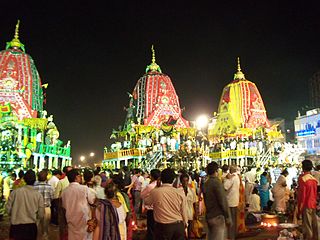
Grishma the Sanskrit word meaning summer. This is one of the six seasons (ritu), each lasting two months, the others being: Vasanta (spring), Varsha (monsoon), Sharada (autumn), Hemanta (pre-winter), and Shishira (winter).
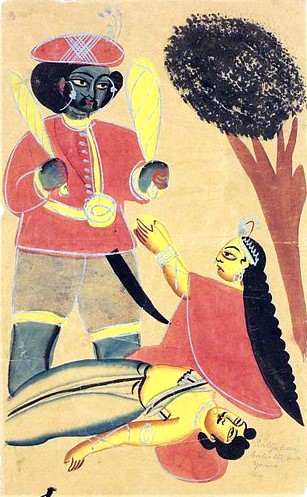
Savitri Vrata or Savitri Amavasya is a fasting day, commemorating the pious act of Savitri who rescued her husband, Satyavan, from the god of death (Yama). It occurs on the new moon day in month of Jyeshtha. Married Hindu women observe a fast to promote a long, healthy life for their husbands. It is celebrated in the Indian states of Odisha, Bihar, Uttar Pradesh and in Nepal.
Pūrṇimā is the word for full moon in Sanskrit. The day of Purnima is the day (Tithi) in each month when the full moon occurs, and marks the division in each month between the two lunar fortnights (paksha), and the Moon is aligned exactly in a straight line, called a syzygy, with the Sun and Earth. Full moon is considered the third of the four primary phases of the Moon; the other three phases are new moon, first quarter moon, and third quarter moon. The full moon shows 100% illumination, causes high tides, and can concur with lunar eclipses.















